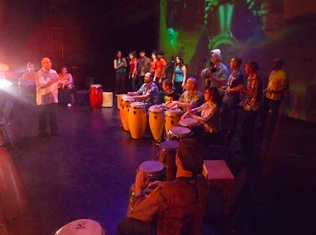We will concentrate on developing hand techniques for tumbadoras (congas) as well as learning the associated percussion parts for each rhythm. Experience of hand drumming is essential for this course.
Percussion instrument techniques covered:
Tumbadoras (congas), Cajones (boxes), Bombo (Cuban carnaval bass drum) Claves, Campanas (bells), Cata (bamboo played with wooden sticks) and Shekeres (beaded gourd shakers).
*Lukumi Bata rhythms will be covered and transcribed to be played on congas however anyone owning bata drums are welcome to bring them down for the relevant sessions.
We will also learn short songs to go with each style in order to place the rhythms within there musical framework. Some instruments will be provided but please bring along your own if you have them.
Rhythms Covered: (selected from the following)
From the Yoruba tradition – Iyessa, Bembe and Reso Obatala (bata).
From the Bantu tradition – Palo and Macuta.
Cuban carnaval Rhythms – Conga Oriental and Mozambique.
Plus an introduction to Cuban rumba – El Yambu.

